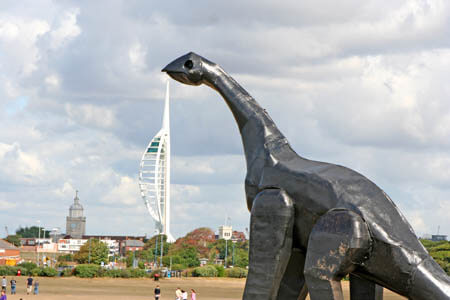Over the summer the city of Portsmouth was graced by the visit of a life-sized sauropod model, standing proud on Southsea Common. The model stood 53ft (16m) tall and 72ft (22m) long and was apparently visible from the Isle of Wight. This was no scientific model, but an artistic sculpture based on brutalist architecture, evident by its square legs and curved forms. Its purpose on Southsea Common was both pragmatic and aesthetic; it functioned as both artwork to admire and a shelter on the common.
The model, called Luna Park, was designed and constructed by Heather and Ivan Morison, two Serbian car factory workers. It was transported from Serbia to Southsea by ship and lorry, separated into six parts, made from a steel skeleton and a hard polyester shell. The model was due to be moved to Colchester on the 10th of October and then on to Cardiff, before it could have potentially returned to Portsmouth permanently.
I first heard about this model due to Facebook, as over summer some friends had seen it. Sadly I had no idea that it was staying for so long, so I never visited it. Sadly, I never will.
The sad bit
This morning, during my palaeobotany lecture, we were told that the sculpture had been set on fire at around 2.00 in the morning (2.40am according to the local newspaper). My lecturer quipped that it might have been some of the vertebrate palaeontologists who work in conjunction with the university, annoyed at some anatomical mistake or some such thing. Sadly the razed dinosaur is likely the handiwork of local idiots engaging in a spot of arson, leaving only a mangled, black frame.
In my opinion this is bad news for Portsmouth. The model had a lot of potential, which interestingly could have some amusing ironic twists accompanying it. The model was steadily becoming iconic and much loved by the locals, but any chance of a permanent model has been ruined. It would have been interesting to have a model dinosaur, despite the fact that none are found in Portsmouth, whereas the Isle of Wight has yielded plenty. The other source of amusement, for me at least, would be the idea of an anatomically incorrect (or rather, simply artistic) dinosaur on the common, when there are qualified vertebrate palaeontologists just down the road. However, even that would not be as amusing as the fact that Genesis Expo is a stone's throw away - the creationist "museum" in Portsmouth, happily promoting the idea of dinosaurs and man living side by side.
The nomen dubium issue
The design of the dinosaur is based on Ultrasauros, which is not a typo for Ultrasaurus. Sadly the BBC News story gets the background to this dinosaur wrong, labelling it a fraud, "fabricated" by Professor Jim Jenson. The only thing they seem to get right is that it was a composite (or chimera) of two different species. The real story is one which any palaeontologist can be sympathetic with and not one of glory-seeking deception.
In 1972 Jensen discovered an enormous sauropod which he named Supersaurus vivianae. He also discovered another huge sauropod in 1979, which he named Ultrasaurus macintoshi, which was nomen nudum as it had not been published. Ultrasaurus was thought to be one of the biggest sauropods. Then in 1983 a palaeontologist called Haang Mook Kim believed he had discovered another species of Ultrasaurus and gave it the name Ultrasaurus tabriensis; Kim did actually publish with this name, which caused problems when it turned out that his analysis was mistaken and these two dinosaurs were not of the same genus. As Kim was the first to publish, due to ICZN regulations the original Ultrasaurus could not be given this name, so in 1991 George Olshevsky renamed it Ultrasauros.
It later turned out that Ultrasauros was not an actual dinosaur, but an accidental combination of the bones of two separate dinosaurs, which were then identified as the already existing genera Supersaurus and Brachiosaurus. The name Ultrasauros is now a junior synonym for Supersaurus as those were the main bones used to "type" the specimen. Interestingly the name Ultrasaurus is now considered nomen dubium as not enough is known about it to warrant it its own genus.
It is startling that the BBC News site got this so wrong, instead stating that it was a case of fraud. Instead it is the usual case of mistaken identity, which happens often with such incomplete fossils.
For the BBC article from before the dinosaur was displayed in Portsmouth see here. For the post-arson article see here. For the local newspaper article, see here.
Subscribe to:
Post Comments (Atom)








No comments:
Post a Comment